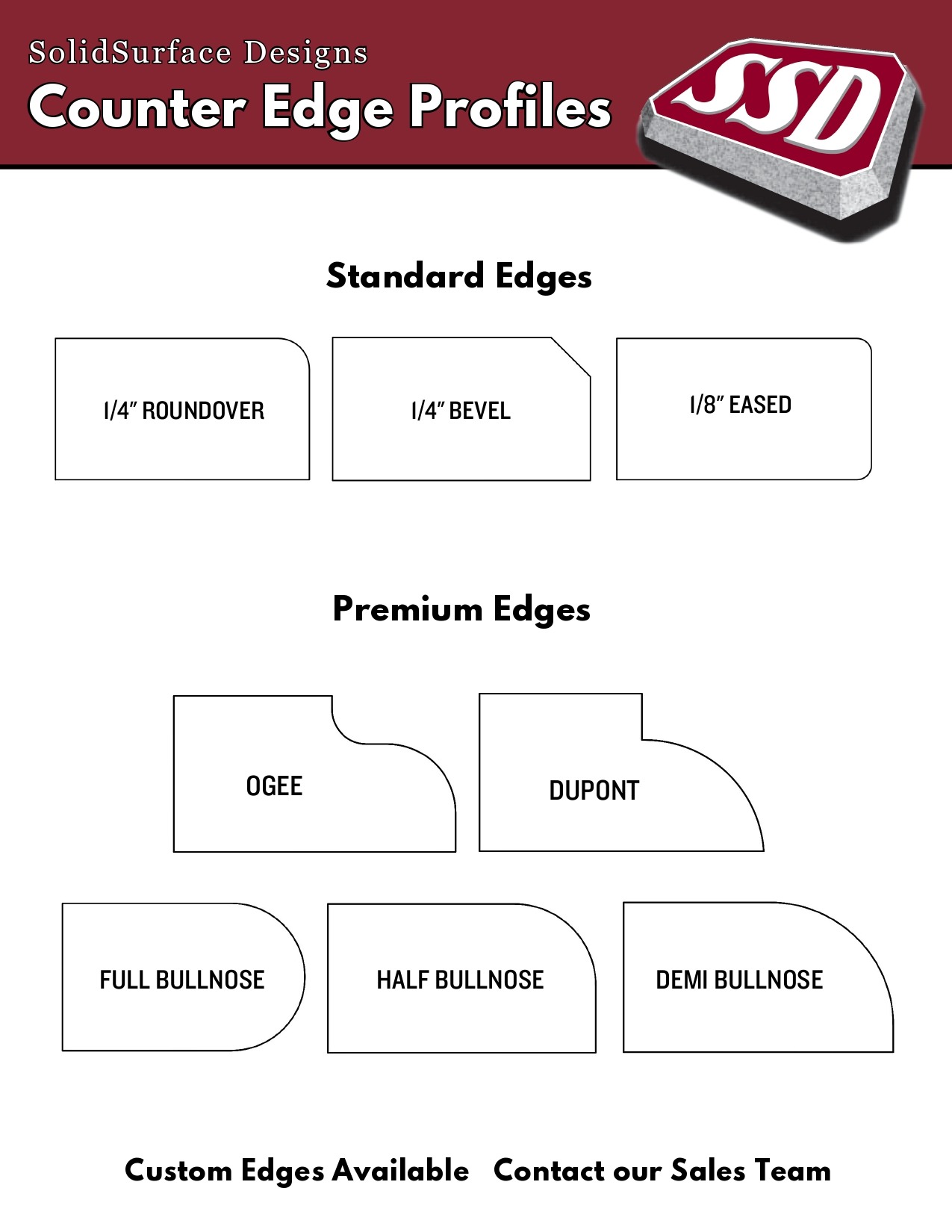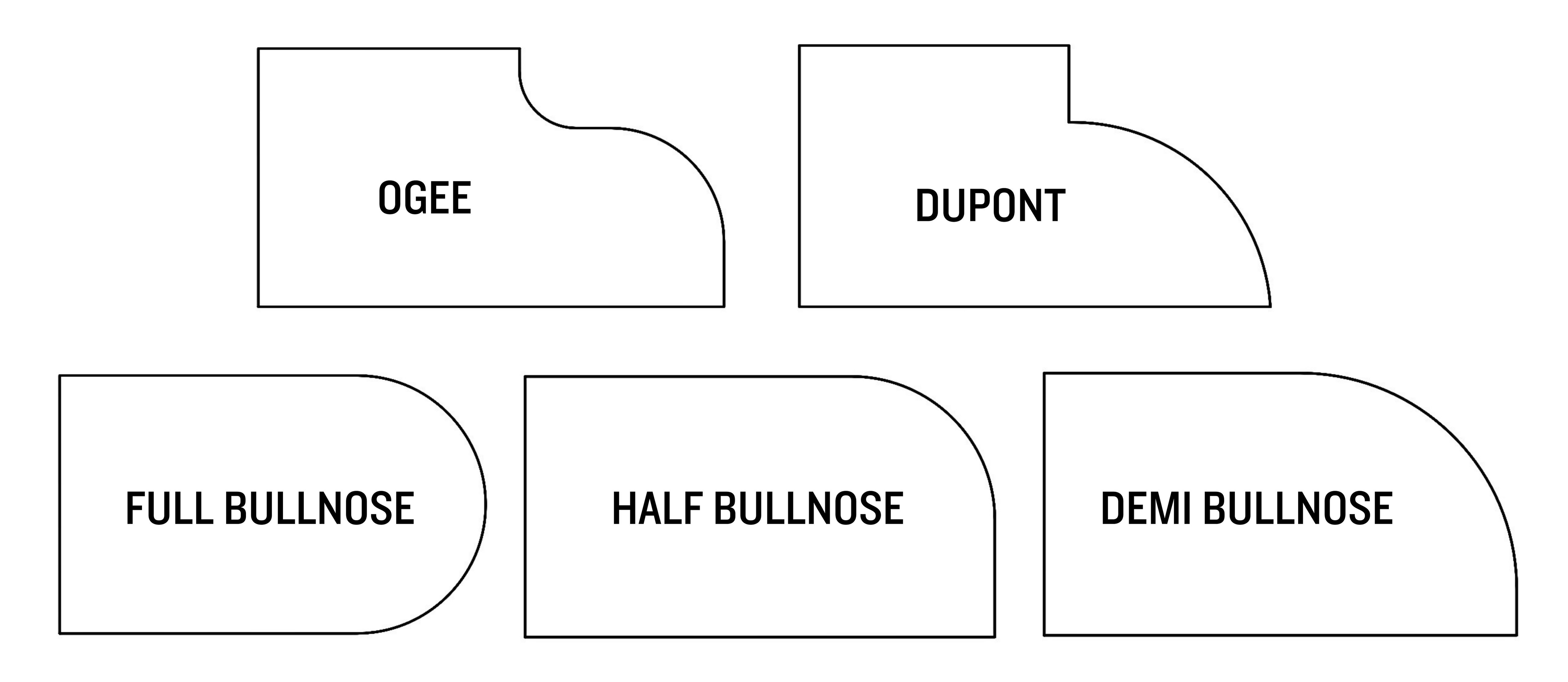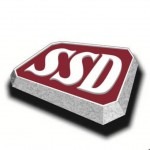When selecting a countertop edge, it’s important to consider your overall kitchen design, personal preferences, and functional requirements. Visualize how the edge will look with your chosen material and review if a profile aligns with your desired aesthetic. Consult your SSD counter professionals who can provide guidance and showcase samples of different profiles to help you make an informed decision.

Standard Edges

1/4" Roundover
The 1/4″ roundover edge is a common choice for countertop edges. It features a slight curve that softens the edge and creates a smooth, rounded finish.
Pros:
- Versatile aesthetic: The 1/4″ roundover edge is a popular choice because it complements various kitchen styles. It can work well with both traditional and modern designs, providing a clean and timeless look.
- Easy to clean: The smooth curve of a roundover edge makes it easier to clean and maintain. There are no sharp corners or crevices where dirt or spills can accumulate.
- Comfortable to lean on: The rounded edge offers a more ergonomic and comfortable surface to lean on while working in the kitchen. It provides a gentler resting place for your arms or wrists compared to a sharp edge.
- Safety: The rounded edge minimizes the risk of injury from sharp corners. This is especially beneficial if you have children or frequently move around your kitchen.
Cons:
- Less visual impact: If you prefer a more decorative or prominent edge profile, the 1/4″ roundover may appear relatively subtle. It doesn’t make as strong of a design statement as more intricate edge profiles. Compared to other edge profiles, such as ogee or bullnose, the 1/4″ roundover edge offers a simpler and less dramatic look. If you’re looking for more intricate edge details, this profile may not fulfill your design preferences.
1/4" Bevel
A 1/4″ bevel edge is another popular choice for countertop edges. It features a sloping angle along the top edge, creating a chamfered effect.
Pros:
- Visual appeal: The bevel edge adds a touch of sophistication and visual interest to the countertop. It offers a modern and sleek look that can complement various kitchen styles.
- Increased durability: The beveled edge provides some protection against chipping and impacts compared to sharper edge profiles. The angled slope helps to distribute the force of impact along the beveled surface, reducing the likelihood of damage.
Cons:
- Limited softening of edges: While the bevel edge offers a slight softening effect, it may not provide the same level of safety as a fully rounded edge profile like a quarter-round. The bevel retains a defined edge that can still pose some risk if bumped or collided with.
- Maintenance challenges: The sloping angle of the bevel edge can make it slightly more challenging to clean compared to a fully rounded edge. Small debris may accumulate along the sloping surface, requiring extra attention during cleaning.
1/8" Eased
A 1/8″ eased edge profile is a simple and subtle choice for countertop edges. It involves slightly rounding the sharp edge to create a smooth and softened appearance.
Pros:
- Clean and modern look: The eased edge offers a clean and minimalist aesthetic, making it suitable for contemporary kitchen designs. It provides a simple yet polished finish that complements various countertop materials.
- Easy to clean: The eased edge doesn’t have sharp corners or intricate details, making it easy to clean and maintain. It doesn’t trap dirt or debris, allowing for quick and efficient cleaning.
- Safe and comfortable: The slight rounding of the edge reduces the risk of injury from sharp corners. It provides a more comfortable surface to lean on or rest your arms while working in the kitchen.
- Versatile and timeless: The 1/8″ eased edge is a classic choice that works well with different kitchen styles. It doesn’t overpower the overall design and can seamlessly blend with other elements in the space.
Cons:
- Less durability against chipping: While the eased edge provides some softening, it may not offer the same level of protection against chipping or impacts as more rounded or beveled edge profiles. The edge retains a defined edge that can be more vulnerable to damage.
- Limited impact on design: If you prefer a more pronounced or decorative edge profile, the 1/8″ eased edge may appear relatively subtle. It offers a straightforward and understated look, which may not suit those seeking more intricate edge details.
Premium Edges

Ogee
An ogee edge is a decorative and ornate edge profile commonly used on kitchen and bathroom countertops. It features a flowing, S-shaped curve that adds a touch of elegance and sophistication to the countertop’s appearance.
Pros:
- Aesthetic appeal: The primary advantage of an ogee edge is its aesthetic appeal. It adds a classic and upscale look to the countertop, enhancing the overall appearance of the space
- Elegance: The flowing curves of the ogee edge profile exude a sense of elegance and luxury, making it an attractive choice for homeowners seeking a high-end look for their countertops.
- Detail and Depth: The intricate design of the ogee edge adds depth and dimension to the countertop, creating a focal point in the room and drawing attention to the countertop surface.
Cons:
- Cost: One of the main drawbacks of using an ogee edge is the cost. The complexity of the design requires more labor and precision during the fabrication process, which can lead to higher production costs compared to simpler edge profiles.
- Maintenance: The ornate design of the ogee edge may require more attention during cleaning and maintenance. Dirt, debris, and spills can accumulate in the crevices and curves of the edge, making it slightly more challenging to keep clean.
- Practicality: The pronounced curves of the ogee edge may reduce the usable countertop space slightly.
- Style Compatibility: While the ogee edge is beloved for its classic and elegant look, it might not suit all design styles. It could clash with more modern or minimalist aesthetics, potentially limiting its versatility.
- Risk of Chipping: The intricate design of the ogee edge could potentially be more vulnerable to chipping or damage, especially in high-traffic areas where objects might accidentally come into contact with the edge.
DuPont
A DuPont edge profile is a unique and eye-catching edge design for countertops. It features a raised, curved edge that resembles the shape of a bird’s beak with an eased edge top.
Pros:
- Distinctive Appearance: The DuPont edge profile is distinctive, making it a focal point in your kitchen or bathroom. It can add a unique and memorable touch to your design.
- Visual Interest: The raised curved edge creates visual interest and dimension, adding depth and character to your countertop surface.
- Design Flexibility: While not as common as other edge profiles, the DuPont profile can work well with various design styles, from traditional to contemporary.
Cons:
- Cost: The fabrication process for a bird’s beak edge can be more complex and labor-intensive, which can lead to higher production costs compared to simpler edge profiles.
- Maintenance Challenge: The raised edge could potentially make cleaning more challenging, as dirt and debris might accumulate in the curved section. Regular cleaning and attention to detail are necessary to maintain its appearance.
- Less Flat Surface: The raised edge creates a slightly smaller usable surface area on the countertop.
- Subtle Balance: Depending on the overall design of the space, the DuPont edge could either stand out as a distinctive feature or blend in too subtly, affecting the desired visual impact.
- Risk of Chipping: The raised design might make the edge more vulnerable to chipping or damage, especially in high-traffic areas where objects might accidentally come into contact with the edge.
Bullnose
A bullnose edge is a classic and versatile edge profile that features a rounded, smooth curve on the top and bottom edges of the countertop. It’s a popular choice for various design styles and applications.
Pros:
- Timeless Appeal: The bullnose edge profile’s simple and rounded design is timeless and can complement a wide range of design styles, from traditional to contemporary.
- Safety: The absence of sharp edges reduces the risk of accidental bumps, making the bullnose edge a safer option, especially in family-friendly environments.
- Comfortable: The rounded profile of the bullnose edge is comfortable to lean against, sit at, and interact with, making it a welcoming choice for kitchen islands and dining areas.
- Easy to Clean: The smooth curve of the bullnose edge is easy to clean and doesn’t create crevices where dirt and debris can accumulate.
- Enhanced Durability: The rounded edge is less prone to chipping or damage compared to more intricate profiles, contributing to the countertop’s overall durability.
Cons:
-
Minimal Focal Point: While the bullnose edge offers a classic and versatile look, it might not provide the same level of drama or visual impact as some more ornate edge profiles. If you’re looking for an edge that serves as a strong focal point or standout feature, the bullnose edge might appear understated in comparison.
Half Bullnose
A half bullnose edge is a variation of the bullnose edge profile, featuring a rounded curve on the top edge of the countertop and an eased edge on the bottom. This edge profile offers a softer look while maintaining some of the benefits of the classic bullnose.
Pros:
- Soft Elegance: The half bullnose edge profile combines the timeless appeal of the bullnose with a softer, more subdued aesthetic. It can add a touch of elegance without being overly ornate.
- Comfort: Like the full bullnose, the rounded top edge of the half bullnose is comfortable to lean against, making it a practical choice for dining areas and kitchen islands.
- Safety: The rounded edge minimizes sharp corners reducing the risk of accidental bumps.
- Easy Cleaning: The smooth curve of the half bullnose edge is easy to clean and doesn’t harbor dirt or debris.
- Versatility: The half bullnose edge profile can work well with various design styles, from traditional to contemporary, offering a degree of design flexibility.
Cons:
- Subdued Focal Point: While the half bullnose provides a pleasing look, it might not create as strong a focal point as more intricate or unique edge profiles.
- Aesthetic Preference: Some homeowners might prefer either a fully rounded bullnose edge or a more linear edge, finding the half bullnose to be a middle ground that doesn’t fully align with their design vision.
Demi Bullnose
A demi bullnose edge is another variation of the bullnose edge profile that features a slightly rounded curve throughout the edge with an eased finish on the bottom, creating a gentler, more rounded appearance.
Pros:
- Subtle Elegance: The demi bullnose edge profile offers a softer and more subtle look compared to the full bullnose, adding a touch of elegance without being overly elaborate.
- Comfortable: The rounded edges on both the top and bottom sides of the countertop provide a comfortable and safe space for leaning against, making it a good choice for family-oriented areas.
- Ease of Cleaning: The smooth curves of the demi bullnose edge are easy to clean and don’t trap dirt or debris.
- Versatility: The subtle curvature of the demi bullnose edge can complement various design styles, from traditional to transitional, offering a degree of versatility.
Cons:
- Limited Focal Point: While the demi bullnose provides a pleasing look, it might not create as strong a focal point or visual interest as more intricate edge profiles.
- Personal Preference: Some homeowners might prefer the fully rounded bullnose edge or a more linear edge, finding the demi bullnose to be a middle-ground option that doesn’t fully align with their design vision.

